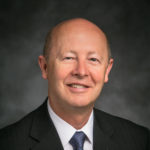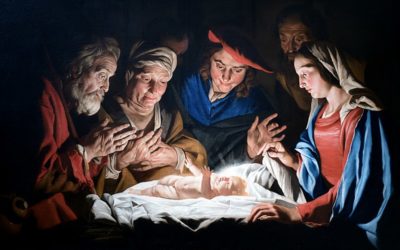In the latter part of 1830, the Church of Christ was only months old. It had a simple leadership structure, multiple branches (churches), and a set of articles and covenants to guide it. It was now ready to grow rapidly. To fuel this growth, it needed a strong missionary force, and Doctrine and Covenants sections 30 to 36 show the development of both full-time and part-time member missionaries between September and December and how the Church grew through their efforts.
September 1830
The Church held an important conference in late September 1830. Just before that conference, Joseph Smith received the revelation that is now section 28 of the Doctrine and Covenants, which among other things called Oliver Cowdery to “go unto the Lamanites and preach my gospel unto them” (verse 8). Just after the conference, the Prophet received three revelations that were later combined into section 30.
Doctrine and Covenants 30:1‒4
The first revelation was directed to David Whitmer and chastised him for fearing man and not relying on God (verse 1). “Your mind,” the Lord told him, “has been on the things of the earth more than on the things of me, your Maker, and the ministry whereunto you have been called; and you have not given heed unto my Spirit, and to those who were set over you, but have been persuaded by those whom I have not commanded” (verse 2). The Lord told him to live at the home of his father, Peter Whitmer Sr., to pray, and to “ponder upon the things which you have received . . . until I give unto you further commandments” (verses 3‒4).
From these verses, it is clear David needed to do some repenting before he was ready to serve the Lord fully. What he did wrong is not clear, but it may be he paid too much attention to the false revelations put forth by his brother-in-law Hiram Page, who did not have authority to speak for the Church as did the Prophet Joseph.
But the Lord also gave David an assignment: “You shall attend to the ministry in the church, and before the world, and in the regions round about” (verse 4). By repenting and fulfilling this calling, David would prepare himself for future work in God’s kingdom.
For further background in this revelation, click here.
Doctrine and Covenants 30:5‒8
Unlike David, who was told to stay home for a while, Peter Whitmer Jr. was commanded to “take your journey with your brother Oliver” on his mission to the Lamanites, “for the time has come that it is expedient in me that you shall open your mouth to declare my gospel” (verse 5). Thus, Oliver and Peter became the Church’s first long-range, fulltime missionaries. Oliver was designated as the senior companion, and Peter was told to “fear not, but give heed unto the words and advice of your brother, which he shall give you” (verse 5).
The direction the Lord gave him applies well to all missionary companionships: “And be you afflicted in all his afflictions, ever lifting up your heart unto me in prayer and faith, for his and your deliverance” (verse 6).
The Lord also described the authority he had given Oliver. “I have given unto him power to build up my church among the Lamanites,” He explained, “and none have I appointed to be his counselor over him in the church, concerning church matters, except it is his brother, Joseph Smith, Jun.” (verses 6‒7). But obedience would bless Peter. “Wherefore,” the Lord concluded the revelation, “give heed unto these things and be diligent in keeping my commandments, and you shall be blessed unto eternal life” (verse 8).
For further background on this revelation, click here.
Doctrine and Covenants 30:9‒11
A third Whitmer brother, John, was given an assignment very much like that of a stake or district missionary today. The Lord commanded him “from this time forth to proclaim my gospel, as with the voice of a trump” (verse 9). But he was to work from “your brother Philip Burroughs’, and in that region round about, yea, wherever you can be heard, until I command you to go from hence” (verse 10). He was, however, to give his calling all the time he had available. “Your whole labor shall be in Zion,” the Lord told him, “with all your soul, from henceforth; yea, you shall ever open your mouth in my cause, not fearing what man can do, for I am with you” (verse 11).
For further background on this revelation, click here.
Doctrine and Covenants 31
The missionary assignment for Thomas B. Marsh contained in Doctrine and Covenants 31 was much like the one given to John Whitmer, except more limited in its time requirement because of his personal circumstances. Unlike John, who was single, Thomas was married. He had been a member of the Church for less than a month, had been ordained an elder, was not quite thirty years old, and was struggling with his wife to raise three children.
With all his inexperience and family challenges, however, the Lord commanded him to “lift up your heart and rejoice, for the hour of your mission is come; and your tongue shall be loosed, and you shall declare glad tidings of great joy unto this generation” (verse 3). The Lord told him to “preach from this time forth” and promised him success in his labors and in his family (verses 4‒5).
But he had to maintain a balance with his family responsibilities. “Behold,” the Lord said of his family members, “verily I say unto you, go from them only for a little time, and declare my word” (verse 6). But if he did what he could, the Lord would grant him success. “Yea, I will open the hearts of the people, and they will receive you. And I will establish a church by your hand; and you shall strengthen them and prepare them against the time when they shall be gathered” (verses 7‒8).
That did not mean his life would be easy. “Be patient in afflictions,” the Lord counseled him. “Revile not against those that revile. Govern your house in meekness, and be steadfast.” (Verse 9.) But the Spirit would guide him if he remained worthy. “Go your way whithersoever I will,” the Lord promised, “and it shall be given you by the Comforter what you shall do and whither you shall go” (verse 11).
For further background on this section, click here.
October 1830
As you can imagine, the fulltime mission call of Oliver Cowdery and Peter Whitmer Jr. created quite a buzz among Church members at the time. In early October, another revelation on the mission, now section 32 of the Doctrine and Covenants, gave additional details about this extraordinary mission that would have a huge impact on the future of the Church.
Doctrine and Covenants 32
This revelation added two more missionaries to the Missouri-bound group—Parley P. Pratt and Ziba Peterson—who were to go “into the wilderness among the Lamanites” (verse 2). Even more important would be their Unseen Companion. Jacob 5:72 in the Book of Mormon promised that when the Lord’s servants labored in His vineyard in the last days, He would labor with them. The new revelation reinforced the promise: “I myself will go with them and be in their midst,” the Lord promised, “and I am their advocate with the Father, and nothing shall prevail against them” (verse 3). This is a promise to which all of the Lord’s servants are entitled.
But there was also a condition. “They shall give heed to that which is written, and pretend to no other revelation,” the Lord commanded, a particularly important revelation given Hiram Page’s recent false revelations. “And they shall pray always that I may unfold the same to their understanding.” (Verse 4.)
For further background on this section, click here.
Doctrine and Covenants 33
Parley P. Pratt baptized Ezra Thayer and Northrop Sweet, and within a month of their baptisms, they were called on missions by the revelation that is now section 33 of the Doctrine and Covenants. “Ye are called to lift up your voices as with the sound of a trump, to declare my gospel unto a crooked and perverse generation,” the Lord told them. “For behold, the field is white already to harvest; and it is the eleventh hour, and the last time that I shall call laborers into my vineyard.” (Verses 2‒3.)
Subsequent verses of the revelation continue the analogy of the harvest field. “The field is white already to harvest; wherefore, thrust in your sickles, and reap with all your might, mind, and strength” (verse 7). “Open your mouths and they shall be filled, . . . Yea, open your mouths and spare not, and you shall be laden with sheaves upon your backs, for lo, I am with you” (verses 8‒9).
In Matthew 13:5‒6, Jesus spoke of seeds that “fell upon stony places, where they had not much earth,” so that “when the sun was up, they were scorched; and because they had no root, they withered away.” Such was Northrop Sweet, who soon left the Church. Ezra Thayer eventually faded too, but not before he fulfilled the mission he had been given and gathered a large congregation for Joseph Smith and others to address.
For further background on this section, click here.
November 1830
Doctrine and Covenants 34
Parley P. Pratt was a great missionary, and among those taught by him was his brother Orson Pratt, who had just turned nineteen at the time. On November 4, 1830, Joseph Smith received a revelation for Orson, who like his brother would go on to become a great leader in the Church and have tremendous influence for good. In this revelation, now section 34 of the Doctrine and Covenants, the Lord testified of Himself and commended Orson “because you have believed” (verse 4). “And more blessed are you because you are called of me to preach my gospel—To lift up your voice as with the sound of a trump, both long and loud, and cry repentance unto a crooked and perverse generation, preparing the way of the Lord for his second coming.” (Verses 5‒6.)
“Wherefore,” the Lord commanded him, “lift up your voice and spare not, for the Lord God hath spoken; therefore prophesy, and it shall be given by the power of the Holy Ghost. And if you are faithful, behold, I am with you until I come—And verily, verily, I say unto you, I come quickly. I am your Lord and your Redeemer. Even so. Amen.” (Verses 10‒12.)
For further background on this section, click here.
December 1830
Doctrine and Covenants 35
As the fulltime missionary group sent to the Lamanites passed through Ohio on their way to Missouri, Parley P. Pratt contacted members of his previous religious congregation, many of whom eventually joined the Church. The most influential of these was his minister, Sidney Rigdon. The revelation that is now section 35 of the Doctrine and Covenants was received on December 7, 1830, and gave direction to Sidney on his future. Among other things, Sidney was directed to serve as Joseph’s scribe. Sidney went on to become one of the Church’s most prominent members, especially during the Ohio period of its history. He eventually became a member of the First Presidency for a time.
For further background on this section, click here.
For more information on the 1830‒1831 mission to the Lamanites, see here.
Doctrine and Covenants 36
Accompanying Sidney to New York was another prominent Ohio resident, Edward Partridge. The revelation that is now section 36 of the Doctrine and Covenants was received by Joseph Smith for Edward on December 9, 1830. In the revelation, the Lord told Edward he was “called to preach my gospel as with the voice of a trump” (verse 1). “And I will lay my hand upon you by the hand of my servant Sidney Rigdon,” the Lord promised, “and you shall receive my Spirit, the Holy Ghost, even the Comforter, which shall teach you the peaceable things of the kingdom; and you shall declare it with a loud voice, saying: Hosanna, blessed be the name of the most high God” (verses 2‒3).
This revelation also showed how universal the command was for men to preach the gospel in those early days of the Church. “And now this calling and commandment give I unto you concerning all men,” the Lord announced. “That as many as shall come before my servants Sidney Rigdon and Joseph Smith, Jun., embracing this calling and commandment, shall be ordained and sent forth to preach the everlasting gospel among the nations—Crying repentance, saying: Save yourselves from this untoward generation, and come forth out of the fire, hating even the garments spotted with the flesh. And this commandment shall be given unto the elders of my church, that every man which will embrace it with singleness of heart may be ordained and sent forth, even as I have spoken.” (Verses 4‒7.)
The active missionary work launched during the latter part of 1830 led to many converts, especially in the Ohio area, and before long there were more members of the Church and better opportunities for growth there than in New York.
For further background on this section, click here.
(Credit for image at top of page: Detail of 1839 engraving made from Karl Bodmer painting of Indians on Missouri, public domain, copied from https://upload.wikimedia.org/wikipedia/commons/8/8a/Punca_or_Ponca_indians_encamped_on_the_banks_of_the_Missouri_0011v.jpg [accessed April 2, 2021].)



